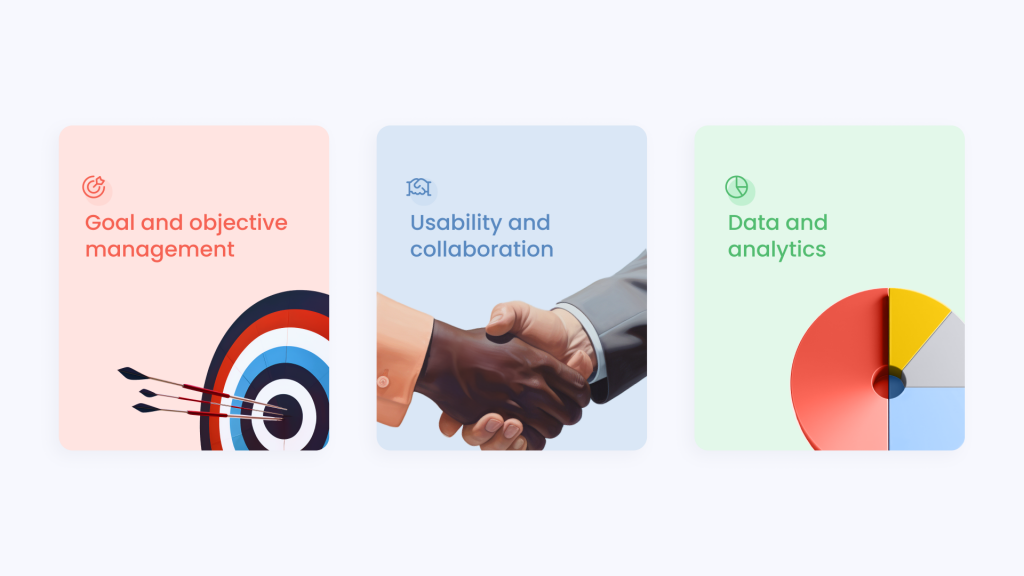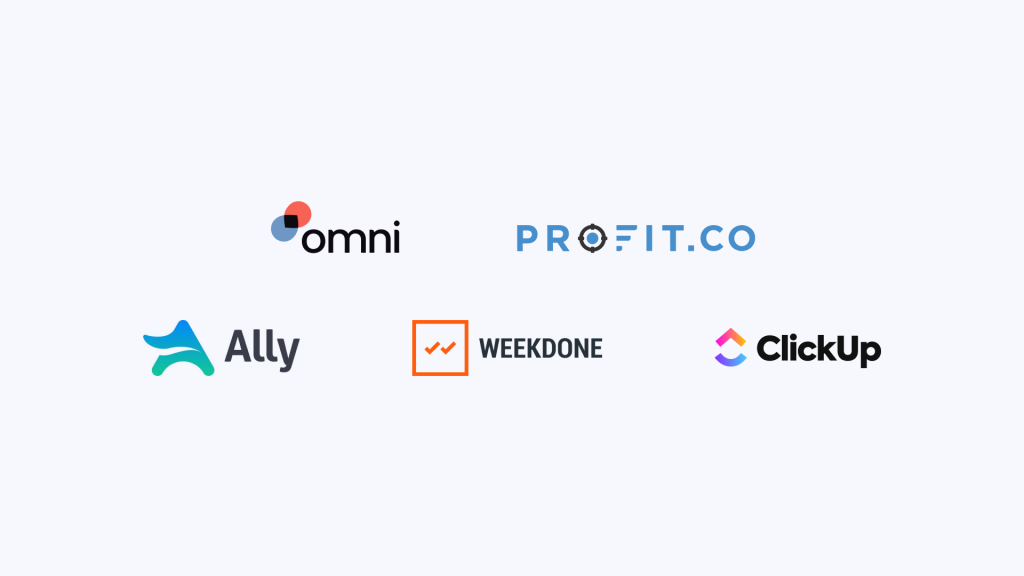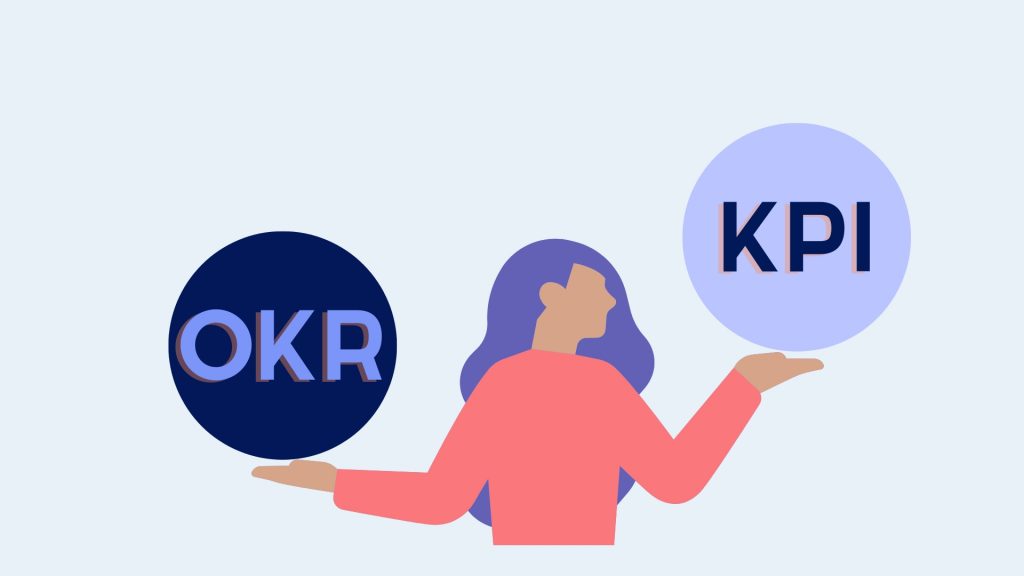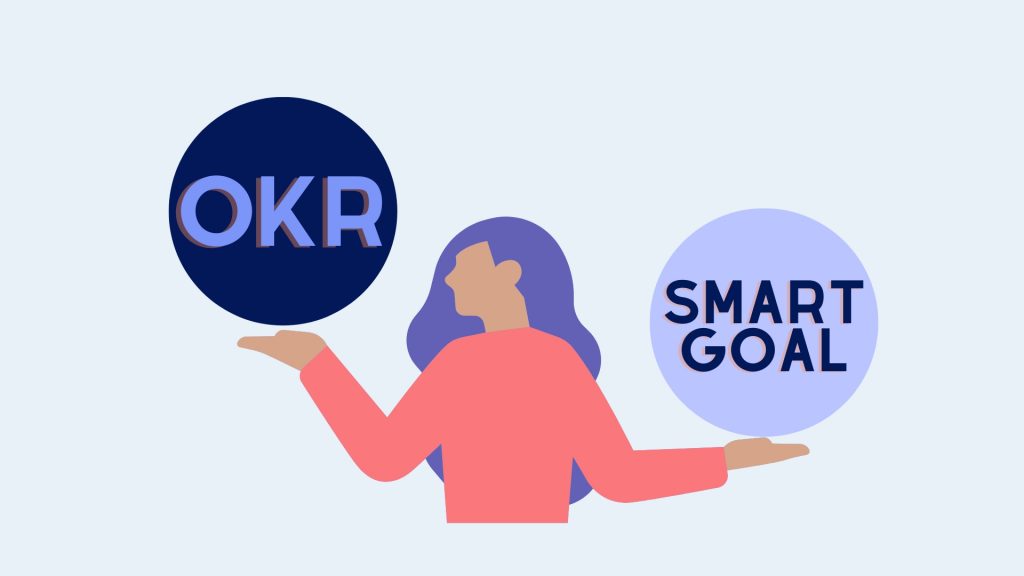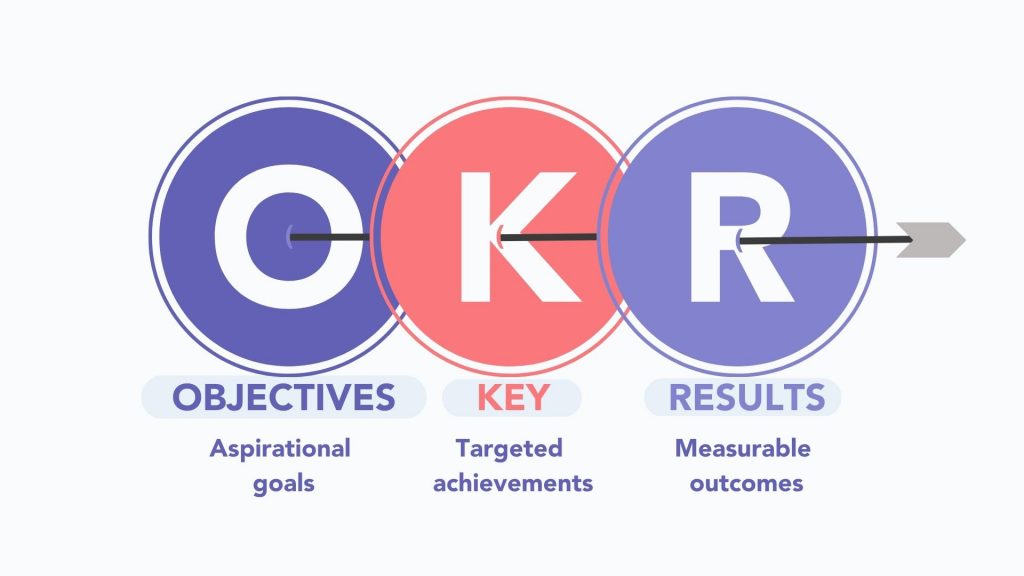We’ve written a lot about Objectives and Key Results (OKRs) before. And that’s because OKRs are becoming an essential component of goal settings for organizations around the world. In a nutshell, OKRs provide a framework to set, track, and iterate on company wide objectives. But to do so effectively, you’re going to need to consider OKR scoring.
As any HR professional knows, no two OKRs are the same. Some will have a more significant impact, others can be accomplished in the short term. To help prioritize them, implementing a scoring system is an essential component of an OKR framework.
In this article, we’re going to take a look at OKR measurement, and walk you through the different OKR scoring systems, how to choose the right one for you, tips to make the most of it, and the benefits you can expect.
What is OKR scoring?
Once you’ve laid out your OKRs, you’re on the right track to achieving your team’s goals. But establishing objectives, and actually measuring progress towards them are two different things. That’s where OKR scoring comes in.
Think of it like a progress report for your OKRs. It’s a way to measure how far along you are in achieving your goals. By assigning scores to your Objectives and Key Results, you get a clear picture of what’s working and what’s not, allowing you to adjust your strategy as needed.
The reasons you’re going to want to implement OKR scoring are:
- Transparency: Everyone on the team can see exactly how they’re doing and where they can improve.
- Motivation: Seeing those scores inch closer to 100% can be a real motivator for your team members.
- Accountability: It keeps everyone accountable for their contributions to the team’s goals.
- Data-Driven Decisions: Scores provide valuable data to help you make informed decisions about your OKRs and overall strategy.
What are the types of OKR measurement?
Once you have your OKR framework, it’s time to decide how you’ll measure progress. There are a few popular methods, each with its own pros and cons, and what you ultimately go with needs to reflect the unique nature of your organization.
0 to 1 scale
This is the most common and straightforward approach. Each OKR is given a score between 0 (not achieved) and 1 (fully achieved). It’s easy to understand and works well for quantitative metrics like revenue or customer satisfaction. It’s pretty clear that there’s not a lot of nuance, which might leave you without the full picture. But the ease of implementation and understanding makes the 0 to 1 scale a popular OKR measurement.
Grading system
If your OKRs are more qualitative (like “improve employee engagement“), a grading system (A, B, C, etc.) might be a better fit. You can define what each grade means in terms of achievement. This is of course going to inject a bit more subjectivity to the scoring process, so make sure you approach each grade with clear, objective and consistent reasoning.
Relevant reading: 6 Types of Rating Biases That Affect Performance Reviews
Weighted scale
Not all OKRs are created equal. A weighted scale lets you assign different levels of importance to your Objectives and Key Results. This way, you can prioritize certain goals over others and see how each contributes to the bigger picture. Similar to the grading system, it’s important you have a repeatable and unbiased approach when assigning weighted values to your OKR calculation.
Hybrid approach
Why limit yourself to one method? Many teams use a combination of approaches to get the best of both worlds. For example, you could use a 0 to 1 scale for quantitative Key Results and a grading system for qualitative ones.
The best scoring system for your team depends on your specific goals, how you like to track progress, and the overall culture of your organization. There’s no one-size-fits-all answer, so experiment and find what works best for your organization.
What are the benefits of OKR scoring?
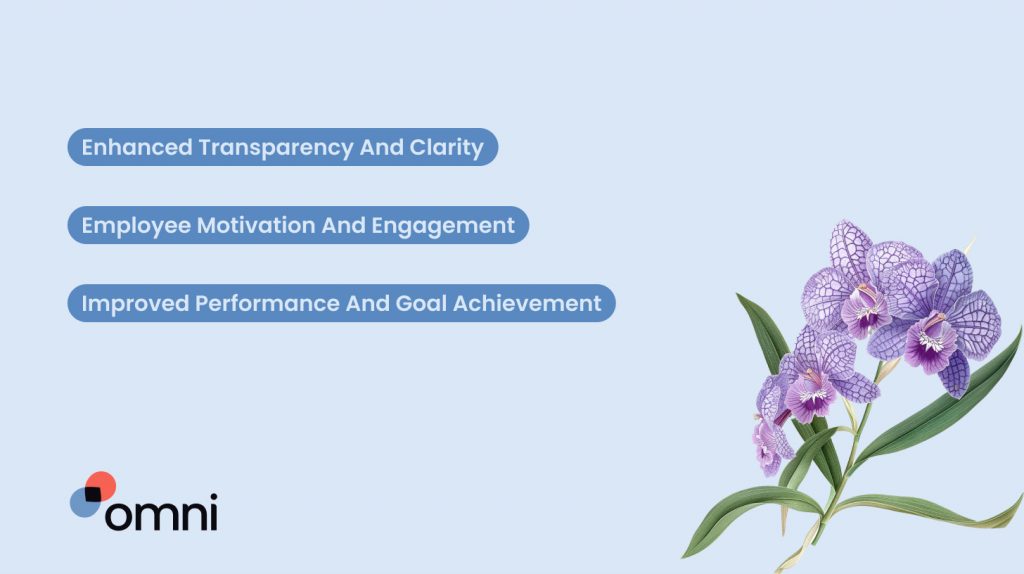
OKR scoring isn’t just about adding numbers to your goals—it’s a powerful tool that can supercharge your team’s performance and create a more positive work environment. Here’s some of the major benefits for you to consider:
Enhanced transparency and clarity
- Everyone’s on the same page: OKR scoring removes any ambiguity about progress. Everyone can clearly see how your team is doing and what needs more focus.
- Open communication: Scoring promotes open conversations about what’s working and what’s not, leading to better collaboration and problem-solving.
- Data-driven decisions: Instead of relying on gut feelings, scoring provides concrete data to help you make informed decisions about your strategy.
Improved performance and goal achievement
- Focused effort: Scoring helps your team prioritize their work and allocate resources to the areas that will have the biggest impact.
- Early detection of issues: If a Key Result is falling behind, you can address it early on before it becomes a major roadblock.
- Continuous improvement: By tracking progress, you can identify patterns and areas where you can optimize your processes and strategies.
Employee motivation and engagement
- Sense of progress: Regularly seeing their scores increase can be incredibly motivating for your team members. It reinforces the impact of their work and makes them feel invested in the team’s success.
- Autonomy and ownership: OKR scoring empowers individuals to take ownership of their goals and make decisions about how best to achieve them.
- Recognition and celebration: When goals are met, celebrating those achievements helps build a positive and supportive team culture.
By tracking progress, celebrating wins, and learning from challenges, you’ll be well on your way to reaching and exceeding the goals you lay out for yourself and your team.
Read next: Understanding and Implementing Stretch Goals for Employees
How to build an OKR scoring system?
Building a great OKR scoring system isn’t just about plugging numbers into a spreadsheet. It’s about creating an OKR measurement that aligns with your company culture, increases transparency, and drives continuous improvement. Here are the five steps you need to take to build an OKR framework that will work for your organization:
1. Choose a scoring scale
We’ve already discussed the different scoring methods (0 to 1 scale, grading system, weighted scale, or hybrid). Choose the one that best aligns with your team’s preferences and the nature of your OKRs.
Consider: are your goals mostly quantitative or qualitative? Do you need to prioritize certain Key Results? Your answers will help you narrow down the options. Also think about your company culture. Is it more data-driven or collaborative? Your scoring system should reflect the way your team works best.
2. Define scoring criteria
For each Key Result, create a detailed breakdown of what it means to achieve a specific score. For example, on a grading system scale, what does it mean to achieve an A? What are the fundamental differences separating a B from a C?
Be as specific as possible, and try to develop clear scoring guidelines that everyone on the team understands. This will help ensure consistency and avoid any confusion or disagreements.
3. Promote transparency and communication
While it can be tempting to keep your scoring methodology private, OKR calculation works best with transparency. Share it with your entire team and explain how it works, and encourage questions and feedback. Make the scoring criteria easily accessible to everyone. This could be through a shared document, an internal wiki, or even a dedicated OKR management tool.
4. Integrate regular reviews
Set up regular check-ins (weekly, bi-weekly, or monthly) to review progress and update scores. This will keep everyone on track and allow for timely adjustments. Use the scoring system as a basis for constructive feedback, and focus on celebrating successes and finding ways to overcome challenges. This will help you to establish a culture of learning and growth. You can also review past OKR scoring to identify patterns and areas for improvement in your overall strategy.
4. Utilize tools and resources
There are many great OKR management tools available to streamline the process, including comprehensive HRIS platforms, like Omni. These tools can help you set goals, track progress, collaborate with your team, and automatically calculate scores.
5 Tips for an Effective OKR Framework
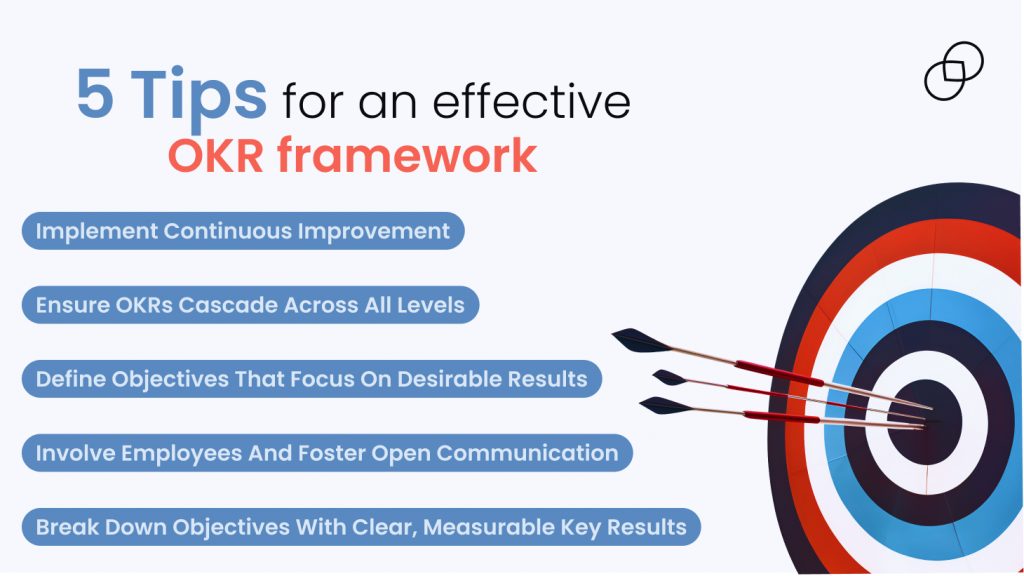
Now that we’ve dealt with the fundamentals of building your OKR scoring framework, it’s time to dive into the ways you can maximize its potential. Here are five tips for you to consider to level up your OKR calculation game:
1. Ensure OKRs cascade across all levels
Your organization-wide OKRs should be the North Star guiding everyone’s efforts. Break them down into smaller, more specific OKRs for each department, team, and even individual. This way, everyone understands how their work contributes to the bigger picture.
2. Define objectives that focus on desirable results
Your objectives should be about the results you want to achieve, not just the tasks you need to do. Instead of saying, “launch a new marketing campaign,” aim for something like, “increase website traffic by 20%.” This shift in focus will encourage creative problem-solving and drive real impact.
3. Break down objectives with clear, measurable key results
Each Objective should have a few Key Results that are specific, measurable, achievable, relevant, and time-bound (SMART). These metrics should clearly indicate whether you’re on track to achieve your Objective. For example, instead of saying, “improve customer satisfaction,” you might have a Key Result like, “increase customer satisfaction rating by 10% within the next quarter.”
4. Involve employees and foster open communication
OKRs aren’t just for managers. Involve your team members in setting their own OKRs. This will boost their sense of ownership and engagement, leading to better results. Encourage open communication and regular check-ins to discuss progress, challenges, and learnings.
5. Implement continuous improvement
A good OKR is one with the flexibility to change if need be. They should be living, breathing documents that evolve as your business does. Encourage a culture of continuous improvement by regularly reviewing your OKRs, adjusting them as needed, and learning from both successes and failures.
Revolutionizing Performance Management with Omni
OKRs are one of the most effective frameworks for establishing business goals, and developing a sustainable tracking system will help your organization efficiently implement and sustain OKR goal setting for your entire business.
Omni’s performance management system powers your business with access to reports and analytics that provide valuable insights for measuring key results. Easily set, track, and measure OKRs across your teams within one, intuitive dashboard.
To learn more about how Omni can help you unlock your business’ potential, schedule a demo with our team today.







